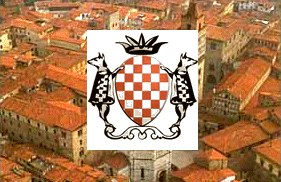     |
 DISCOVERING
PISTOIA DISCOVERING
PISTOIA
OSPEDALE DEL
CEPPO
 The
old custom of placing alms in a hollow tree trunk inspired the Pistoia
legend that tells of a pious couple, Antimo and Bandinelia, who in the
late 1200s saw an apparition of the Virgin Mary who instructed them to
found a hospital in the place where they would find a trunk flowering in
the dead of winter. Hence the name and symbol of the Pistoian welfare
institution whose duties included helping the poor and curing the sick.
Because of the role they played in society, the Ospedale and similar
institutions served an essential function in the city especially during
the frequent calamities that afflicted Medieval society. The
old custom of placing alms in a hollow tree trunk inspired the Pistoia
legend that tells of a pious couple, Antimo and Bandinelia, who in the
late 1200s saw an apparition of the Virgin Mary who instructed them to
found a hospital in the place where they would find a trunk flowering in
the dead of winter. Hence the name and symbol of the Pistoian welfare
institution whose duties included helping the poor and curing the sick.
Because of the role they played in society, the Ospedale and similar
institutions served an essential function in the city especially during
the frequent calamities that afflicted Medieval society.
The hospital was at first just one of several institutions making up the
city's health system but it was to become, especially during the
terrible plague year narrated by Boccaccio, the most powerful welfare
organization in Pistoia, thanks also to the estates and donations that
it received. Confirmation of this prestige can be seen in the fact that
in the late 1400s the Ospedale became the object of bitter fighting
between opposing factions led by the noble Panciatichi and Cancellieri
families of Pistoia who were vying for the hospital's top administration
post. Inevitably, Florence intervened to reconcile the two factions and
placed the hospital under the administration of the Ospedale di Santa
Maria Nuova in Florence. In the meantime, the modest Medieval rooms of
the Pistoian institution had been enlarged and the colonnade facing onto
the piazza was added. (Thus the building took on the architectural
elements of Brunelleschi's style which can be seen in the Ospedale degli
Innocenti in Florence.) The polychrome frieze over the portico was
commissioned by the Administrator Leonardo Buonafede in order to promote
the hospital's charitable goals and to propagandize the new Florentine
management. The Ceppo became, presumably in the 1500s, the seat of a
medical school that over the centuries trained good doctors, among whom
the anatomist pathologist Filippo Pacini for whom the nearby street is
named. Remnants of the school are found today in the collection of
ancient medical instruments displayed in the Museo dell'Accademia Medica
del Ceppo.
Managed by the Santa Maria Nuova Administrators, the hospital grew until
it took over other similar institutions. At the end of the 1700s it
became the city hospital, a function it still serves today.

PISTOIA
PHOTOGALLERY
PISTOIA CITY MAP
|

